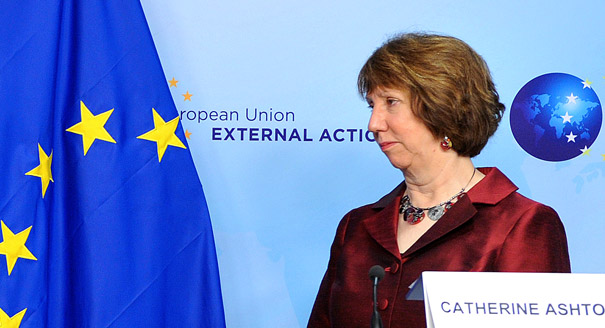2014 will be a hypercharged year for EU foreign policy. Turkey, Russia, Ukraine, Syria, Egypt, Palestine, Afghanistan, and transatlantic trade all loom large on the agenda. Additional entanglements in tension-ridden Africa and even Asia could quickly emerge as well. Whether the EU can perform as a relevant and reliable player in these theaters will depend largely on whether the brittle relationship between the EU’s member states and its Brussels-based foreign policy service can play out constructively.
The unloved child in this relationship is, still, the European External Action Service (EEAS). While cooperation between the member states and the European Commission (whose external relations portfolios include trade, development, neighborhood policy, enlargement, and humanitarian aid) is a much-practiced, decades-old enterprise, the relationship between EU capitals and the EEAS is still young and lacks trust or depth.
Most critical assessments of the EEAS’s work cite a profound lack of member-state “buy-in” into the service as a main obstacle to its proper functioning. But what exactly is that “buy-in”? What can the member states do to develop a healthier EEAS and take some of the strain out of the relationship?
First and foremost, EU leaders should give the service’s top job of high representative to a fearless, experienced, entrepreneurial foreign policy practitioner when the current incumbent, Catherine Ashton, steps down this year. Ideally, the EU’s new foreign policy chief would also have a knack for bureaucratic politics and team building and a keen sense for member states’ jealousies and national idiosyncrasies. The new high representative should be a diplomat who accepts the supremacy of the member states in foreign policy, but who does not shy away from leading the leaders—and has the clout and expertise to get away with it.
Many fear that in the grand bazaar of distributing top EU jobs that will take place in 2014, the position of high representative will once again be a tertiary consideration after the bigger posts of European Commission president and European Council president have been allocated. Treating the EEAS again in such an openly dismissive way would send a devastating signal to its staff. It would not be “buy-in” but sell-out.
Second, member states should task the EEAS much more with suggesting policies and diplomatic solutions to foreign policy problems. This has not been done systematically and directly enough in the past. Not only would national governments profit from the EEAS’s considerable in-house expertise, they would also send a political signal about their willingness to think about foreign policy, at least partly, in a pan-European way. As a positive side effect, national leaders would also support the emergence of a healthy esprit de corps inside the service.
Third, the member states should work hard to implement large parts of the reform agenda that Ashton identified to improve the internal working and external impact of the EEAS. That would include giving the service a meaningful budget to finance its activities and straightening out its less-than-ideal organizational setup.
Fourth, the member states should force the next commission president to strike a positive deal with the new high representative on a more cooperative division of labor between the commission and the EEAS. The warfare between the two institutions is politically damaging for all involved and must stop.
Fifth, the work of the EEAS needs to be more strongly reconnected to the EU rotating presidency that still exists in other policy fields. That does not mean turning back the clock to pre–Lisbon Treaty practices, but capitalizing on the energy that new countries bring to the presidency every six months and making the rotation system productive for foreign policy once more. This could also have the positive upshot of curbing the role of the European Council president in the field of foreign policy. Under the current arrangements, the council’s foreign policy components have swollen to an oversized and unnecessary parallel structure.
Finally, the member states should give the new high representative a strong and clear mandate to revitalize his or her additional role as head of the European Defense Agency. In the past, Ashton made very little use of this subsidiary post, which resulted in lost opportunities and wasted time in a crucial policy field.
None of these empowering measures would require treaty change or substantial additional costs. None of these steps would undermine member states’ supremacy and sovereignty in the field of security and defense. The risk that a newly emboldened service could take over foreign policy, communalize it, and run the show independently is nonexistent.
On the other hand, the possible additional foreign policy firepower that could come from an encouraged, properly equipped, and well-structured institution could be substantial. At a time when the limits of the EU’s established foreign policy methods have become painfully obvious, that could be a major gain at a very moderate price.






